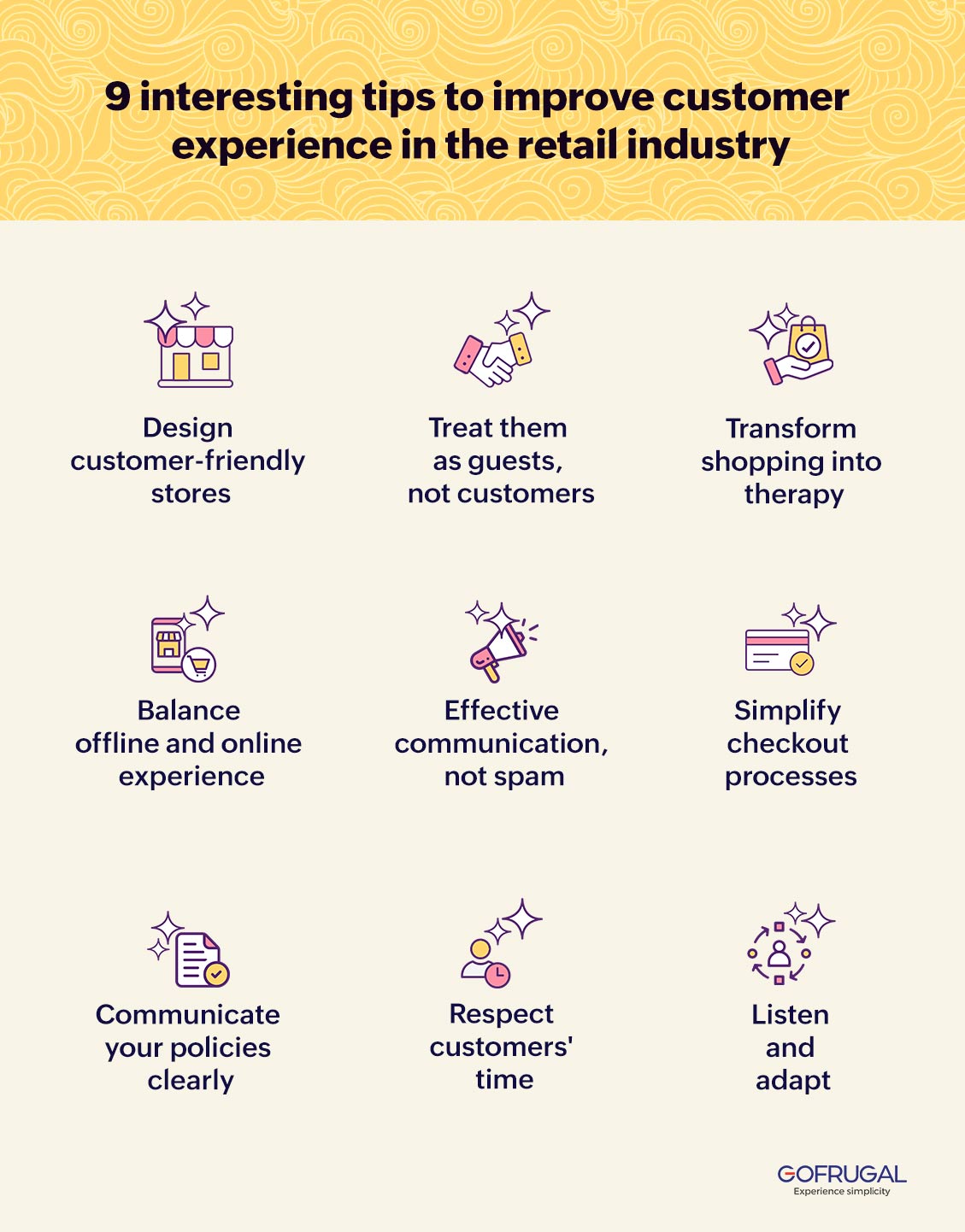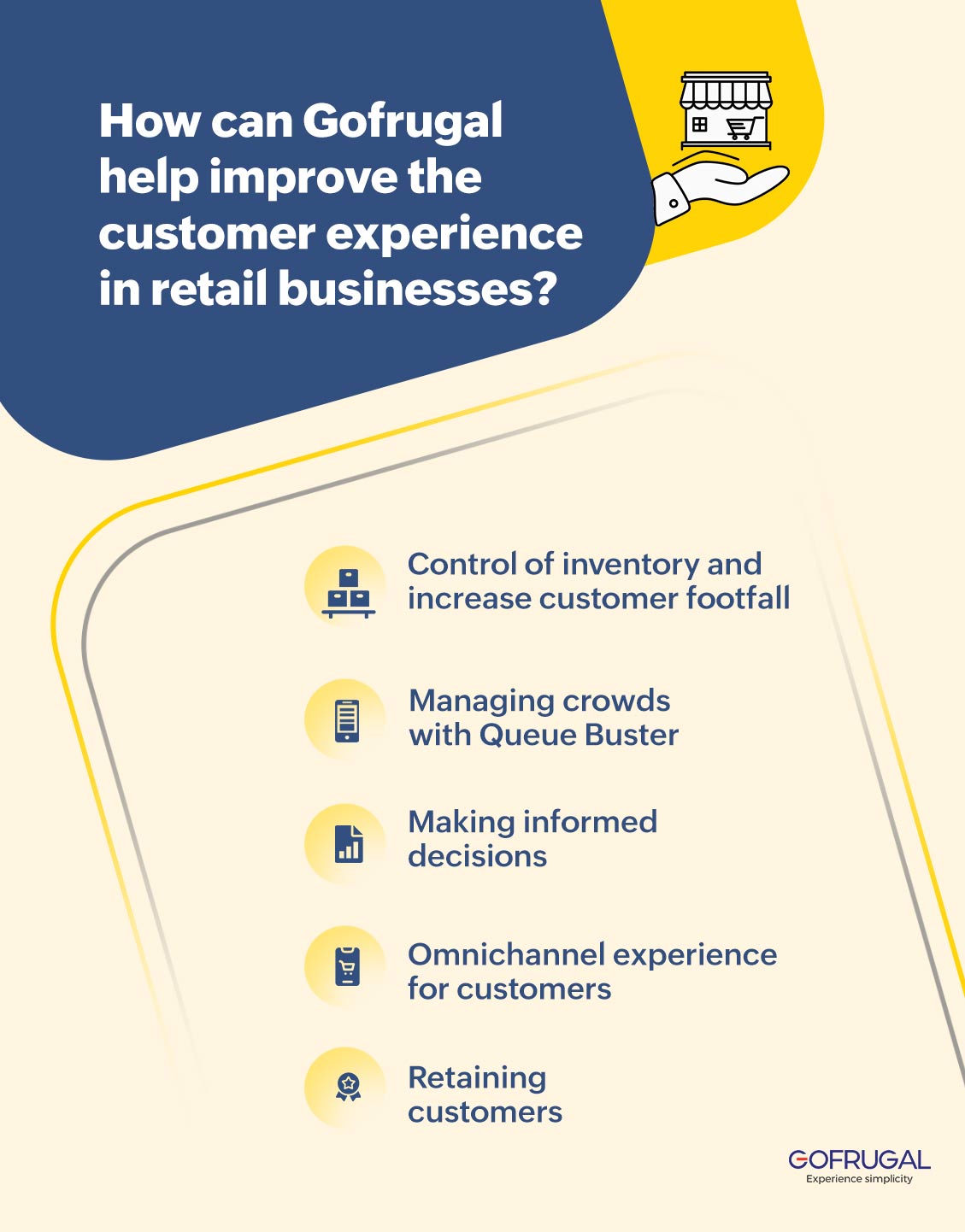Key takeaways:
- Learn the difference between customer experience (CX) and customer service in retail.
- Discover nine actionable tips to elevate the CX in your retail store.
- Explore five real-life examples of excellent customer service in retail.
- Find out how Gofrugal can help streamline processes to enhance your retail customer experience.
Social media shorts and reels are full of feel-good videos showing positive, and sometimes heartwarming, customer service interactions. As a retail store owner, you might be wondering what you can do to improve your customers’ experience in your store to the point where they can’t wait to return and bring their friends and family. This guide aims to help you reevaluate your processes and see what you can do to offer the best customer experience every day.
Contents
- What is retail customer experience?
- Why is the customer experience in retail stores important?
- What’s the difference between customer experience and customer service in retail?
- 9 interesting tips to improve customer experience in the retail industry
- 5 examples of good customer service in the retail industry
- How can Gofrugal help improve the customer experience in retail businesses?
What is retail customer experience?
Customer experience represents the overall impression a customer forms about a company or brand through their interactions. It includes every touchpoint, from the initial encounter to follow-up interactions post-purchase.
In today’s dynamic retail landscape, customer interactions have evolved significantly compared to a decade ago. The advent of technology, particularly ecommerce, has changed the way people shop.
Now, customers engage with brands through a range of touchpoints, including websites, apps, newsletters, and, in some cases, without ever stepping foot inside a physical store. This close-knit web of interaction makes it imperative for the retail customer journey to maintain consistency across all aspects, such as website design, apps, and physical spaces. This consistency is what customers not only desire but expect, as it contributes to an exceptional customer experience.
It’s essential to recognize that the customer experience can either fortify or fracture the bond between companies and their customers. A positive customer experience fosters loyalty, builds trust, boosts sales, and elevates overall customer satisfaction. Conversely, a poor customer experience can drive customers to sever ties with a brand altogether.
Why is the customer experience in retail stores important?
The importance of the retail shopping experience cannot be overstated. Enhancing this experience is the cornerstone of sustained success in the retail industry. To put it simply, whether customers engage with your business online or in person, their perception of your brand forms the core of their experience, and this perception is what they share with others.
If customers find pleasure in their interactions with your brand, its products, and services, they are more likely to return, mirroring the inclination to spend more time with those held in high regard.
Moreover, the shopping experience holds significance because modern customers are exceptionally well-informed and knowledgeable. In the past, retail store owners only had to prioritize making sales over delivering exceptional customer service. However, this paradigm has shifted dramatically.
Today’s shoppers wield an arsenal of information and product reviews at their fingertips, thanks to the internet. No longer can retail business owners ignore the power of the retail customer experience.
What does this evolving landscape mean for retailers like you? It necessitates the delivery of an exceptional customer experience to not only capture the attention of shoppers but also differentiate themselves from competitors.
Your primary focus should be on serving, educating, and delighting customers, aligning with the changing expectations of a more informed and discerning customer base.
What’s the difference between customer experience and customer service in retail?
The difference between customer service and customer experience lies in the scope, approach, and metrics involved in each concept. Here’s a breakdown of the key differences.
Customer service
- Revolves around a single touchpoint in the customer journey that is initiated by the customer seeking assistance.
- Starts as a reaction to customer outreach for issue resolution.
- Focuses on efficiency and problem resolution, including metrics on response times and customer satisfaction.
Customer experience
- Encompasses all customer interactions, aiming to delight at every stage.
- Takes a holistic and proactive approach to create positive impressions.
- Focuses on customers’ overall sentiment and emotional connection with the brand.
- Tracks metrics including NPS, CSAT, and CES to gauge satisfaction and loyalty.
9 interesting tips to improve customer experience in the retail industry
Here are a few interesting and actionable tips that can help you improve customer experience right away.
Design customer-friendly stores
Your store layout and design should be intuitive and aesthetically pleasing, guiding customers through their journey easily. Customers will take one look at a cluttered, poorly planned store with narrow aisles and decide to leave quickly or never come back. Consider factors like aisle width, product placement, organized displays, and signage to enhance their experience.
Treat them as guests, not customers
Train your staff to offer a warm welcome and exceptional service. Encourage them to go the extra mile, making customers feel valued and appreciated. Personalization can also play a significant role in building strong relationships. Keep watch to identify customers struggling to maneuver through the crowd and offer help to them in a sincere way.
Transform shopping into therapy
Sometimes shoppers come into a store tired or with more negative energy. Create an ambiance that’s relaxing and enjoyable. Think about soothing lighting, pleasant music, and comfortable seating areas. Consider offering experiences like product demonstrations or samples that elevate the shopping experience. Let their shopping experience be a relaxing one.
Balance offline and online experience
Ensure that your online presence mirrors the in-store experience. Consistency in branding, product information, and customer service across all channels is key to building trust and loyalty. Continuously monitor your ecommerce store to find bugs, glitches, and turn-offs. Closely study the cart abandonment rate and fix the root causes by offering good online shopping experience.
Effective communication, not spam
Keep customers informed about promotions, new arrivals, and relevant information through channels they prefer, like email or mobile apps. Avoid bombarding them with excessive or irrelevant messages, which can be perceived as spam. Understand customer preferences and the frequency that work for campaigns, then work on communications.

Simplify checkout processes
Make the checkout process as straightforward as possible. Reduce waiting times, offer multiple payment options, and provide a hassle-free billing experience with mobile POS or queue busters. To optimize the online checkout experience, streamline the process, offer guest checkout options, and provide essential information on shipping and payment. Your staff can leave a positive impression by communicating policies, offering gifts to paying customers, discreetly handling declined cards, and soliciting feedback.
Communicate your policies clearly
Ensure that every customer who makes a purchase is well-informed about your exchange and return policies. If you sell online, make sure your privacy policy is crystal clear as well. Misunderstandings can lead to frustration and anger if a customer believes they can return an item but later discovers it’s only eligible for an exchange.
Respect customers’ time
Implement time-saving solutions such as express checkout lanes, self-checkout options, or appointment-based shopping experiences to respect your customers’ time and make their visits efficient. Don’t let them get caught between employee disagreements, slow systems, lack of customer history, and improper rack management.
Listen and adapt
As a retailer, understanding and meeting your customers’ needs is paramount, and to do so, you must actively seek their feedback. You can easily collect customer input by linking online surveys to receipts, offering incentives like small gifts for participation, or providing the option to fill out quick hard copy surveys in your store. This proactive approach not only helps identify customer preferences, but also demonstrates your commitment to delivering an exceptional shopping experience.
5 examples of good customer service in the retail industry
There are plenty of good customer service experiences in the retail industry that exemplify what you should aim for as a retail business owner. Here are five scenarios for you to consider.
Receiving a sincere apology
Nothing beats an apology when a customer is upset and disappointed. In one instance, a consumer purchased an item as a gift for a friend. They were supposed to get it before the day of the event, but the item didn’t arrive on time. The customer reached out to the seller expressing their disappointment and requesting a refund. In response, the seller offered a genuine apology and granted the refund. So, while the customer was disappointed by not receiving the item on time, the business’s efforts to offer an apology and remedy the situation with a refund kept the customer happy.
Expediting delivery for special occasions
Retailers can go the extra mile by ensuring timely delivery, especially for products intended for special occasions is absolute bliss. Imagine a woman planning her wedding. She finds the perfect item she’s missing for her wedding, but time is of the essence. She sees that the standard delivery time won’t work for her schedule, so she reaches out to the customer service team and requests an expedited delivery explaining the reason for it. The team responds in a supportive manner ensuring the delivery will be sped up to get to the nervous bride-to-be on time.
Making returns guilt-free
Retailers can simplify the return process, eliminating customer apprehension. For example, a customer goes to the store with a list made by their spouse but purchases the wrong items than the list intended. They return to the store seeking to make a return to appease their partner, but they didn’t save the receipt. Instead of turning the customer away, the store manager or owner can use different ways to verify the purchase and process the return for the customer. One way to do this is by using the customer’s phone number and searching for the billing history attached to it. With that small measure, the manager or owner can keep their customer happy and protect their business.
Value time and energy
Shopping from a hypermarket does not mean one has to purchase many items; sometimes a customer runs in to pick up one urgent item. In this instance, the customer would love a quick checkout because they only have one item instead of a whole cart of products. Express checkout lines reserved for smaller amounts of items can help keep customers happy and keep queues manageable.
Perfect consultative approach
Having well-informed employees can create a huge difference. Sometimes customers come into stores with no idea of what they are really looking for or how to choose between certain items. If your staff knows the particulars about your products or services, they can properly inform and help even the most confused and unprepared shopper.
How can Gofrugal help improve the customer experience in retail businesses?
With the right digital technology by your side, you can improve the customer experience in your retail business right away. That’s what Gofrugal has been doing for close to two decades.

Control of inventory and increase customer footfall
Gofrugal’s inventory management app, GoSure, ensures retailers have the right products in stock at all times. This leads to reduced instances of products being out of stock, ensuring customers find what they need when they visit. As a result, improved inventory control can increase customer footfall, as shoppers are more likely to visit when they trust the store to have the items they want.
With Gofrugal’s artificial intelligence and machine learning-based autonomous tool, The Eye, you can make proactive analyses on the reason stockouts could happen, and calculate the estimated business loss for stockout instances to prevent it.
Managing crowds with Queue Buster
Queue Buster is a valuable tool to manage and optimize customer queues, reducing wait times at checkout. Enhance the shopping experience by providing a more efficient and pleasant in-store journey, minimizing customer frustration caused by long lines. With this, peak hour sales and festival season crowds need no extra hands or effort. Gofrugal’s GoBill mobile application helps you bill on the go from anywhere in the shop.
Making informed decisions
Gofrugal’s 300+ business intelligence POS reports offer valuable data and analytics that help retailers make informed decisions. Understanding customer preferences, buying patterns, and sales trends empowers retailers to optimize their product offerings and marketing strategies, ultimately leading to a better-tailored shopping experience.
Omnichannel experience for customers
Gofrugal enables retailers to seamlessly integrate their online and offline channels, be it marketplace, ecommerce, or open API. This creates an omnichannel experience for customers, allowing them to shop online, in-store, or both, as per their preferences without missing out on the customer experience they expect from the brand. This flexibility and consistency across channels contribute to an enhanced overall customer experience. You can also get your own branded online ordering app with OrderEasy and let consumers shop from you at their convenience. Launch your own online ordering app with the easy ERP integration.
Retaining customers
By utilizing data and customer insights, Gofrugal assists retailers retain customers through tailored rewards and promotions. This ensures they continue to patronize the store, contributing to a more satisfying and lasting customer experience. Bring back your lost customers, convert non-buyers to buyers, increase the cart value of your customers, and keep nudging your customers to make a purchase. Create repeat customers and attract new buyers to your store with loyalty programs based on points or amounts with membership cards for your customers.
Hopefully, this guide helps you implement changes to offer your customers the best possible experience with your business. Find out how Gofrugal can help your staff focus on what matters most: great customer experiences. Get a demo today!

